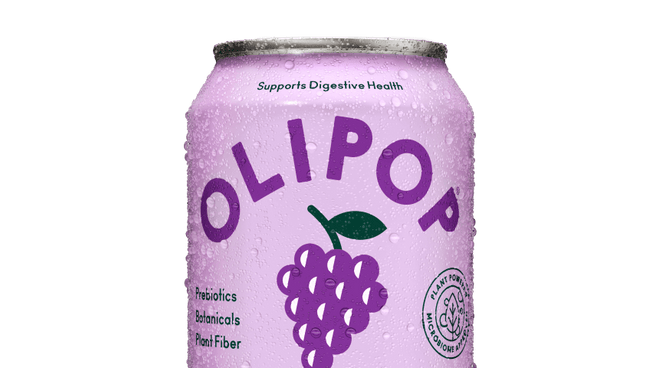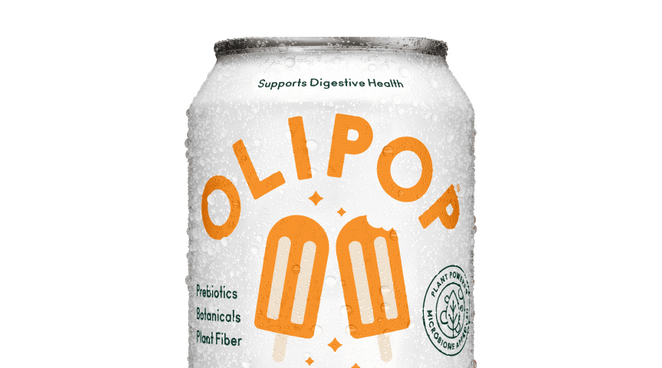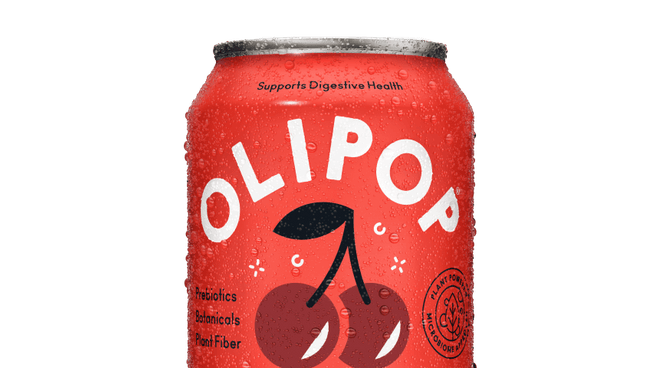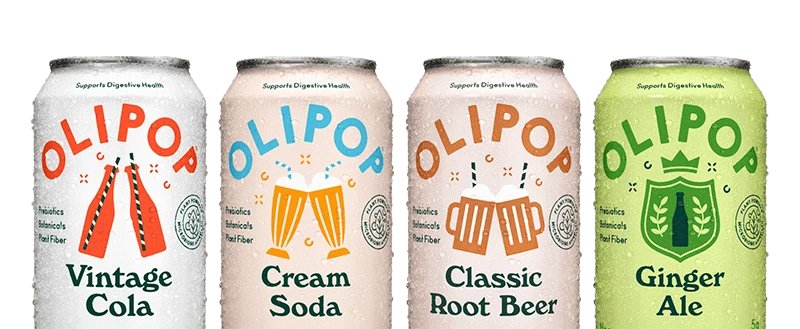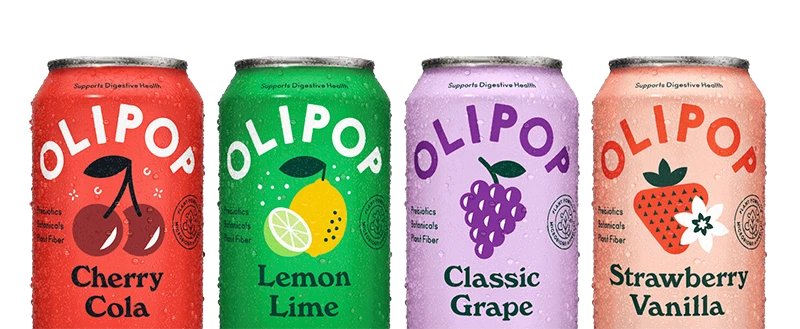Fiber is the talk of the town! Everyone is always lecturing about how important fiber is in your diet and how you should be eating more of it. So you began to look for ways to include this magical ingredient in your diet... only to discover that there are two types of fiber: soluble and insoluble.
Things just got more confusing. So you turned to Google and landed here. Sound about right? Well, welcome to OLIPOP. Let's get started breaking down the details on all things soluble vs insoluble fiber so you can get on with your day (and feel healthier along the way!).
What is Fiber?
Dietary fiber, sometimes referred to as roughage or bulk, comprises the components of plant foods your body can neither digest nor absorb. Unlike other food elements—fats, proteins, and carbohydrates—that your body breaks down and absorbs, your body cannot digest fiber. Instead, it passes through your stomach and colon relatively intact. But just because your body can't digest it doesn't mean it's useless!
Soluble vs Insoluble Fiber
There are two types of dietary fiber: soluble and insoluble. Your body needs both to maintain proper digestive health. Here is the difference between the two:
- Soluble fiber: Dissolves in water. The result is a gel-like substance that slows down the digestive process and makes you feel full.
- Insoluble fiber: Does not dissolve in water. Instead, it passes through your small intestine into the large intestine, where it draws water into your stool for aided bowel regulation. Essentially, this fiber acts as bulk to keep your digestive system running smoothly. [1]
Alright, that's a (very) brief overview of the differences between soluble and insoluble fiber. Let's dig a little deeper.

Soluble Fiber
If you've ever seen or eaten chia seeds and noticed the gel that forms around them, then congratulations: you've seen soluble fiber in action. Soluble fiber is the type of fiber we use in OLIPOP.
This soluble fiber may also work as a prebiotic and comes from ingredients including chicory root, cassava root, and Jerusalem artichoke. This invisible fiber is in every can of OLIPOP because it supports your digestive health. But just because you can't see them doesn't mean these plant fibers aren't working hard for your health with every single sip.
What is Soluble Fiber?
Soluble fiber is part of your dietary fiber intake, and it does everything from aiding in digestion to supporting your immune system. When soluble fiber enters your stomach, it begins to collect water, dissolving and turning into a gel. And this gel helps slow down your digestion.
As a “get-it-done” and “get-it-done-fast” society this may sound like a bad thing, but we promise you it’s not. Here’s the thing: when your digestion slows down, your body can better absorb the vitamins and nutrients from your food. It also helps you feel more full.
Soluble fiber also works as a prebiotic, aka the key to the balance of your gut's microbiome. Prebiotics are metabolized by the colonic microbiome, promoting the growth of certain good bacteria species while encouraging the release of metabolites such as short-chain fatty acids. [2]
Benefits of Soluble Fiber
Beyond aiding digestion, there's a wealth of information and research surrounding the many ways soluble fiber benefits your health. For example, "prebiotic" fiber (aka a type of soluble fiber) is critical and works as food for the beneficial bacteria living in your gut.
Looking for your bottle of probiotics or think we made a spelling mistake writing 'pre' not 'pro’? Well, we’re impressed by your diligent reading comprehension! But, we actually did mean ‘prebiotics’. Probiotics and prebiotics are different and play different roles in your health and digestion. Essentially, probiotics are beneficial bacteria, and prebiotics are food sources for the probiotics.
Prebiotics refers to a diverse category that includes carbohydrates, resistant starches, pectins, and other beneficial ingredients that your army of good bacteria (probiotics) loves to eat. By feeding them prebiotics, you’re strengthening and helping maintain your levels of good healthy bacteria.
Sources of Soluble Fiber
Looking to increase your intake of soluble fiber? Thankfully, you don't have to force down chalky fiber drinks or spend your days in a vegetable garden. Today, you can get soluble fiber in a ton of different foods and drinks (hint: OLIPOP 😉). If you're looking for ways to add more soluble fiber to your diet, here's what you have to look for:
- Inulin: Part of the fructan group, inulin is most commonly found in chicory root, asparagus, bananas, garlic, leeks, and onions. We use inulin in our delicious sodas, so they're packed with soluble fiber.
- Gums: Help to stabilize food. When adding more gums to your diet, make sure to look for plant-based, naturally-derived gums like guar and acacia. [3]
- Pectins: Derived from the cell walls of fruits and vegetables. They help to thicken and are most commonly found on the ingredients list of jellies and jams.
- Psyllium: Absorbs water in the intestines to help add bulk to your stool. This polysaccharide comes from Plantago ovata seeds and is often added as a powder to food or drink.
- Fructooligosaccharides (FOS): Short fructose chains that are often used as an alternative to sugar due to their prebiotic effects and beneficial mineral absorption. You can find FOS in fruits, vegetables, and grains such as chicory, asparagus, onions, wheat, and tomatoes.
- Beta-glucans: Sugar compounds that serve as the primary form of fiber found in the cell walls of cereals, grain, and fungi (think mushrooms!). You can find beta-glucans in bacteria, yeast, fungi, algae, and plants such as oats and barley.
Insoluble Fiber
Now that we've discussed soluble fiber, it's time to address insoluble fiber. Refresher: insoluble fiber is the kind that does not dissolve in water. Like soluble fiber, insoluble fiber is good for your health but plays a different role.
What is Insoluble Fiber?
Warning: a little bit of potty talk is coming your way! If insoluble fiber had a resume, it would spend a long time talking about..... how it softens your stool and makes it easier to pass through your colon. As insoluble fiber passes through your small intestines, it draws water into the large intestine, which helps keep your stool soft and leads to a more enjoyable bathroom experience.
Benefits of Insoluble Fiber
Insoluble fiber has many benefits, especially when it comes to "regulation." Unlike soluble fiber, insoluble fiber speeds up your digestion. It's the ying to soluble fiber's yang. By speeding up your digestion, insoluble fiber helps waste continue moving through your bowels, preventing occasional constipation. [4]
Insoluble fiber also increases fecal bulk. Insoluble fiber works to help fecal material move through your digestive system and increase stool bulk. This is essential for maintaining digestive regularity — and particularly helpful for those who struggle with occasional constipation.
Sources of Insoluble Fiber
Whole grains, whole wheat, seeds, nuts, and root vegetables, like the following, are common types of insoluble fiber-rich foods:
- Wheat bran
- Corn bran
- Oats
- Popcorn
- Nuts and seeds
- Potatoes
- Carrots
- Beets
- Brown rice
- Flaxseed
- Green beans
The average diet usually contains a little more insoluble fiber than soluble. But on the whole, the average American's fiber intake is significantly lower than the recommended daily allowance.
Back when we were hunter-gatherers, humans consumed 150 grams of fiber a day, but today, we aren’t even close to this number! In fact, 95% of Americans don’t consume the recommended amount of fiber. While the FDA recommends 28 grams a day, most of us only get 16 grams a day. This massive deficiency is what nutritionists refer to as the “fiber gap”. [5]
Why OLIPOP Uses Soluble Fiber
Soluble fiber, the invisible fiber, is hiding in every can of OLIPOP supporting your digestive health. Just because you can’t see them, doesn’t mean these plant fibers from chicory root, cassava root, and Jerusalem artichoke aren't working hard for you with every sip.
We added soluble fiber because it’s hardly noticeable in your drink. And with it, we're helping close the fiber gap. Modern, fast diets that rely on fast foods and preservatives have reduced the amount of important fiber in our diets. That 'fiber gap' causes a whole host of health problems, especially in the microbiome.
Wait, what's the microbiome? The microbiome is the collection of microorganisms that live in, on, and around our bodies. Our microbiome is most concentrated in our digestive system and can impact everything from mood and mental function to immunity, skin health, metabolism, and, of course, digestive health.
OLIPOP is a science-backed functional soda designed to bring fiber back into the American diet. We've assembled a global team of leading human gut microbiome research pioneers with diverse expertise spanning digestive health, prebiotic structures, model gut systems, and gut microbiome-supportive nutritional strategies. We work with them to translate cutting-edge research and findings into OLIPOP's product development.
Every can of OLIPOP is made with OLISMART. This is a blend of several unique botanicals, plant fibers, and prebiotics (the primo food source for beneficial bacteria) — each hand-picked for their distinct biome-supporting benefits. While eating a balanced diet rich in whole foods like fruits, vegetables, legumes, and whole grains is ideal for getting adequate fiber, we’re happy to help you take your first step.
Soluble vs Insoluble Fiber: The Takeaway
Soluble vs. Insoluble? Don’t compare! Your body needs both. You need soluble fiber to slow digestion, help your body absorb nutrients, and feed the good bacteria in your gut, so it functions properly.
On the other hand, you need insoluble fiber to make your trips to the bathroom consistent, on schedule, and well, more enjoyable. Incorporating OLIPOP into your diet is an easy and delicious way to give your body some fantastic, intentional ingredients that support your digestive health. Plus we're adding some of the fiber you need to lead a healthier, more balanced life.
Sources
-
James M. Lattimer and Mark D. Haub, “Effects of Dietary Fiber and Its Components on Metabolic Health,” Nutrients 2, no. 12 (December 15, 2010): 1266–89, https://doi.org/10.3390/nu2121266.
-
“Probiotics, Prebiotics and the Gut Microbiota,” ILSI, n.d., https://ilsi.org/publication/probiotics-prebiotics-and-the-gut-microbiota/.
-
Bernice Karlton‐Senaye and Salam Ibrahim, “Impact of Gums on the Growth of Probiotics,” unknown, July 1, 2013, https://www.researchgate.net/publication/281787450_Impact_of_gums_on_the_growth_of_probiotics.
-
“Harvard Health,” Harvard Health, June 1, 2011, https://www.health.harvard.edu/womens-health/ask-the-doctor-what-are-the-differences-between-soluble-and-insoluble-fiber.
-
“2015-2020 Dietary Guidelines,” accessed May 12, 2021, https://health.gov/our-work/food-nutrition/2015-2020-dietary-guidelines/guidelines/appendix-7/.
- There are two types of dietary fiber: soluble and insoluble.
- Soluble fiber dissolves in water; this fiber slows down the digestive process and makes you feel full.
- Insoluble fiber does not dissolve in water; this fiber acts as bulk to keep your digestive system running smoothly.
- OLIPOP is the first science-backed beverage designed to bring fiber back into the American diet.










